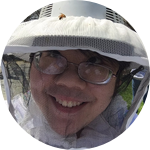About This Project
Research has shown that honeybees use chemical signals as part of the waggle dance to share the location of rich food sources. I aim to determine if chemical signals are also used as part of the stop signal, a regulatory signal used to stop the waggle dancing of bees recruiting to food sources that have become dangerous (e.g. predatory risk). Finding a chemical profile would mean honeybees are more similar to bumblebees than originally thought (as the latter use pheromones to regulate foraging).
Ask the Scientists
Join The DiscussionWhat is the context of this research?
The stop signal is a recently discovered interaction between a honeybee recruiting to a food source using the waggle dance and foragers that have visited that food source to cease stop further waggling. It is used by these foragers to save others and increase colony fitness when that food source turns out to be dangerous for honeybees.
It is characterized by a loud "beeps" and a headbutting motion; I aim to determine if there is also a pheromone-like component to the stop signal as well. This is plausible because the waggle dance itself was originally solely thought of as vibrations in a figure-eight pattern, but has also recently been discovered to involve a chemical signal as well.
What is the significance of this project?
Although the stop signal plays a critical role in maintaining order among honeybee foragers, it is still relatively mysterious. We know that it is used to avoid predation and make collective decisions (by a hivemind, so to speak,) but the mechanisms of the stop signal is still unclear. Identifying chemicals associated with the stop signal would grant us further insight as to how the hive regulates its foraging behavior. It would also provide a connection to the waggle dance, which encourages foraging using chemical signals. This is the first time the mechanisms of the stop signal will be thoroughly investigated.
What are the goals of the project?
In the summer of 2016, I started this research at Swarthmore College and developed the ability to identify waggle dances and stop signals, collect air samples over honeybees using SPME fibers, and, using a computer program, analyze these samples to identify specific chemicals.
This year, I am continuing to collect and analyze air samples over waggle dancers to corroborate the findings in Thom, 2007. I will look compare the chemical profiles of non-dancing foragers, waggle dancers, and stop signalers and identify which compounds are present in one profile and absent in others, contributing to that behavior.
By the summer of 2017, I will have mastered sample collection and analysis, and will collect stop signal samples from multiple colonies for analysis.
Budget
Donations will be used for purchasing additional SPME fiber holders to make the collection of air samples much more feasible. Each SPME fiber must be manually removed from its holder and replaced to collect another sample. Because I am the only person directly working on this research, this is a tedious and time consuming process. The air samples are also highly volatile, so I must analyze them as soon as possible for accurate results. As is, there is some variance in my current observations that, I believe, are caused by degradation in my samples.
I only have one holder for seven SPME fibers. Having several more holders would allow me to obtain and run samples more efficiently without having to worry as much about reassembling each fiber holder and potentially ruining a fiber (they are very fragile!)
I aim to run at least 100 air samples over stop signaling honeybees by the end of summer 2017.
I have everything else required to run my observations.
Endorsed by
Meet the Team
Affiliates
Victor Le
I am a junior at Swarthmore College studying the social behavior of honeybees. I am interested in understanding how and what mechanisms are used by hives to regulate foraging dynamics. I also really enjoy painting bees and watching them crawl around inside their hives.
Christopher Mayack
I first learned about honey bees when conducting a summer undergraduate research internship with Dr. Rudolf Jander, a former graduate student of Dr. Karl von Frisch (Nobel Laureate) that focused on understanding the cognition and navigation abilities of foraging bees at the University of Kansas back in 2005. I graduated with honors in biology and a minor in chemistry from State University of New York at Geneseo in 2007 and then earned a Ph.D. under the guidance of Dr. Dhruba Naug in Zoology at Colorado State University in 2012. During my Ph.D. I was a pioneer studying physiological and behavioral effects of the now world-wide distributed honey bee microsporidian gut pathogen that is implicated to play a role in the most recent bee declines, called Nosema ceranae. I have given multiple disease workshops for local beekeepers and was a member of the Northern Colorado Beekeeper’s Association while in graduate school. I was then awarded a two year Alexander von Humboldt Post-Doctoral Fellowship that was conducted in Germany at Martin Luther University Halle-Wittenberg to work with Dr. Robert Paxton to pursue studies related to the evolution of social behavior in bees. Currently, I am now a Visiting Assistant Professor at Swarthmore College where I mentor a number of undergraduate students interested in studying ways to improve honey bee health, the dynamics of collective decision making, and the metabolic factors involved in the evolution of social behavior. I retain an interest in behavior, disease, and physiology and study these areas using the honey bee as a model organism to determine how stressed bee colonies might collapse. I am particularly interested in how societies remain cooperative when under stress, and at what point do individuals go into "survival" mode and break the social contracts of the society that they live in.
Project Backers
- 4Backers
- 8%Funded
- $109Total Donations
- $27.25Average Donation



